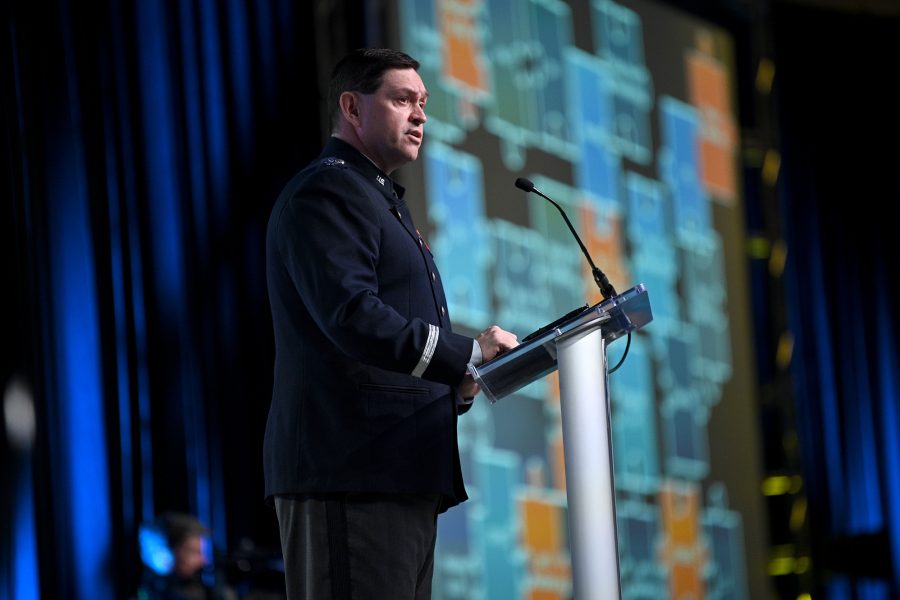The Space Force will establish a service component for U.S. European Command and U.S. Africa Command in early December, Chief of Space Operations Gen. B. Chance Saltzman announced in a keynote address Sept. 12—and more may be on the way.
The new component will “help integrate, collaborate, and cooperate with our joint teammates, partners, and allies in the region,” Saltzman said at AFA’s Air, Space & Cyber Conference.
U.S. Space Forces Europe-Africa will be the fourth USSF service component for a regional combatant command, joining:
- Space Forces Indo-Pacific, which supports U.S. Indo-Pacific Command
- Space Forces Korea, which supports U.S. Forces Korea
- Space Forces Central, which supports U.S. Central Command
In a briefing with reporters after his speech, Saltzman confirmed that the component would mirror and rely upon U.S. Air Forces in Europe-Air Forces Africa, which also serves as the service component for both EUCOM and AFRICOM.
“In the case of Europe, we’re just taking advantage of the fact that USAFE is also the Africa Command support,” Saltzman said. “So because it’s all done from the same location, it’s easy for us to leverage that same construct and really get a two-for-one, to some degree. We will have some people assigned as well to Stuttgart [Germany], where the AFRICOM headquarters is, because proximity matters. And so the service component will kind of have some people spread around to make sure we give all of the attention that both European Command and Africa Command need.”
Plans for a European component have been in the works since the Space Force first announced it would be establishing components for combatant commands outside of U.S. Space Command. The timing, however, was unclear for months. Saltzman credited the delay between Space Forces Indo-Pacific—established in November 2022—and the new European component to their locations.
“When you have to work with host nations, there’s an extra few steps. And so because we stood up Indo-Pacific in Hawaii, we didn’t have to talk to host nations. Central Command was in Tampa, didn’t have to do it. Korea was the closest. We have such a long-standing relationship and a clear Status of Forces Agreement, it wasn’t hard,” said Saltzman. “But with NATO, you got to go through a lot of different countries and the plan is to stand this up in Germany, so we have to talk to the Germans. So just going through all those normal coordination processes just took a little bit longer.”
Once Space Forces Europe-Africa stands up, five of the 11 combatant commands—EUCOM, AFRICOM, INDOPACOM, CENTCOM, and SPACECOM—will have Space Force components. If and when the remaining six will get their own is still being decided, Saltzman said.
Lt. Gen. DeAnna M. Burt, the deputy chief of space operations for operations, cyber, and nuclear, suggested in April that U.S. Cyber Command and U.S. Special Operations Command are prime candidates, given their close ties with space, and Saltzman said Burt is still leading that planning process.
“It will be a balancing act between the responsibilities that those combatant commands have with regards to space … and then the resources I have to put into it,” Saltzman said. “In other words, I don’t want to establish a service component if I can’t resource it effectively. And what these components require is pretty senior people that understand the business. It’s a small number of people, so they have to be really good, they have to have broad understanding. These aren’t brand new, entry-level kinds of people. So there’s a balance between finding the right people to make sure we can support it and finding the right scope of responsibility in the combatant commands, but we’re doing that planning right now.”
The balance of need and resources extends even to the existing components—right now. Saltzman said the plan is for the Europe-Africa component to have an O-6 commander, the same as Space Forces Central. Space Forces Indo-Pacific is the only one—outside of Space Operations Command, which acts as the component for U.S. Space Command—to have a general officer at its head.
“I’m hopeful that with our key threats, we’ll be able to eventually get general officers,” Saltzman said. “We don’t have very many to go around. So this is more about resourcing and placing them right.”
Regardless, the benefits of the regional components is clear, Saltzman said, citing the example of a recent exercise in the Indo-Pacific.
“Having a service component out there before the exercise that’s immediately working with the other operational components, the land component, the air component, etc., to say: ‘What are you going to need from space capabilities?’” Saltzman said. “Documenting those requirements in their battle rhythm, on their time zone. And being able to follow up, ‘Hey, I didn’t really understand this? Can you clarify? Or is this good enough?’ That detailed integration is much harder to do when you’re thousands of miles separate.”
From there, the service components can interact with U.S. Space Command and Space Operations Command and communicate what they need “with the same vocabulary, the same understanding of the missions, same understanding of the people and the capabilities, and it’s a much tighter integration,” Saltzman said.
Exercises are just one benefit—Saltzman said planning, security cooperation, and training allies and partners are all easier with components.
